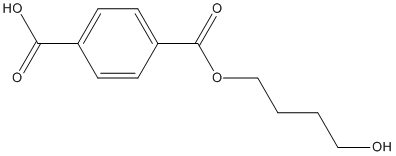BTa
General
Type : Terephthalate || Phthalate
Chemical_Nomenclature : 4-(4-hydroxybutoxycarbonyl)benzoic acid
Canonical SMILES : C1=CC(=CC=C1C(=O)O)C(=O)OCCCCO
InChI : InChI=1S\/C12H14O5\/c13-7-1-2-8-17-12(16)10-5-3-9(4-6-10)11(14)15\/h3-6,13H,1-2,7-8H2,(H,14,15)
InChIKey : QOBMQTZOKFYGNH-UHFFFAOYSA-N
Other name(s) : BT, 4-((4-Hydroxybutoxy)carbonyl)benzoic acid, SCHEMBL1249823, MFCD20259705, ZINC82104103
MW : 238.24
Formula : C12H14O5
CAS_number :
PubChem :
UniChem :
Iuphar :

Target
Families : Polyesterase-lipase-cutinase, Cutinase
References (4)
| Title : Remodeling the polymer-binding cavity to improve the efficacy of PBAT-degrading enzyme - Yang_2023_J.Hazard.Mater_464_132965 |
| Author(s) : Yang Y , Cheng S , Zheng Y , Xue T , Huang JW , Zhang L , Guo RT , Chen CC |
| Ref : J Hazard Mater , 464 :132965 , 2023 |
| Abstract : Yang_2023_J.Hazard.Mater_464_132965 |
| ESTHER : Yang_2023_J.Hazard.Mater_464_132965 |
| PubMedSearch : Yang_2023_J.Hazard.Mater_464_132965 |
| PubMedID: 37979420 |
| Gene_locus related to this paper: 9bact-g9by57 |
| Title : Molecular and Biochemical Differences of the Tandem and Cold-Adapted PET Hydrolases Ple628 and Ple629, Isolated From a Marine Microbial Consortium - Meyer-Cifuentes_2022_Front.Bioeng.Biotechnol_10_930140 |
| Author(s) : Meyer-Cifuentes IE , Wu P , Zhao Y , Liu W , Neumann-Schaal M , Pfaff L , Barys J , Li Z , Gao J , Han X , Bornscheuer UT , Wei R , Ozturk B |
| Ref : Front Bioeng Biotechnol , 10 :930140 , 2022 |
| Abstract : Meyer-Cifuentes_2022_Front.Bioeng.Biotechnol_10_930140 |
| ESTHER : Meyer-Cifuentes_2022_Front.Bioeng.Biotechnol_10_930140 |
| PubMedSearch : Meyer-Cifuentes_2022_Front.Bioeng.Biotechnol_10_930140 |
| PubMedID: 35935485 |
| Gene_locus related to this paper: 9zzzz-Ple628 , 9zzzz-Ple629 |
| Title : Mle046 Is a Marine Mesophilic MHETase-Like Enzyme - Meyer-Cifuentes_2021_Front.Microbiol_12_693985 |
| Author(s) : Meyer-Cifuentes IE , Ozturk B |
| Ref : Front Microbiol , 12 :693985 , 2021 |
| Abstract : Meyer-Cifuentes_2021_Front.Microbiol_12_693985 |
| ESTHER : Meyer-Cifuentes_2021_Front.Microbiol_12_693985 |
| PubMedSearch : Meyer-Cifuentes_2021_Front.Microbiol_12_693985 |
| PubMedID: 34381429 |
| Gene_locus related to this paper: idesa-mheth |
| Title : Substrate specificities of cutinases on aliphatic-aromatic polyesters and on their model substrates - Perz_2016_N.Biotechnol_33_295 |
| Author(s) : Perz V , Bleymaier K , Sinkel C , Kueper U , Bonnekessel M , Ribitsch D , Guebitz GM |
| Ref : N Biotechnol , 33 :295 , 2016 |
| Abstract : Perz_2016_N.Biotechnol_33_295 |
| ESTHER : Perz_2016_N.Biotechnol_33_295 |
| PubMedSearch : Perz_2016_N.Biotechnol_33_295 |
| PubMedID: 26594021 |
| Gene_locus related to this paper: humin-cut , thefu-q6a0i4 |